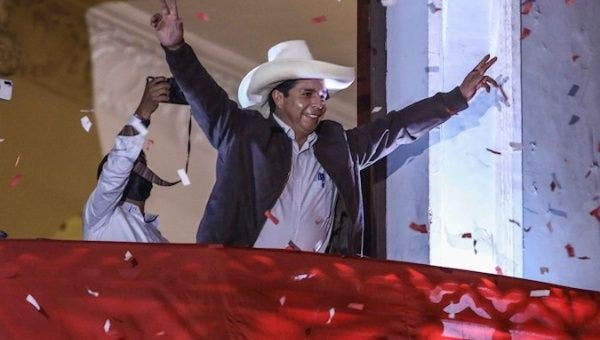
“The Peruvian people have raised their heads to say democratically that we are going to save this homeland,” farmer-turned-teacher, unionist organizer and socialist Pedro Castillo, 51, told supporters the evening of June 15, following the end of ten days of counting ballots.
“Tonight should not only be a night of joy and jubilation but also of great responsibility. We have to be cool because today begins the real battle to end the great inequalities,” Castillo said.
“We are not Chavistas, we are not communists, no one has come to destabilize this country,” he said, a reference to a common refrain from Fujimori’s party and supporters comparing him to Venezuela’s late leftist President Hugo Chavez.
“We are workers, we are entrepreneurs and we will guarantee a stable economy, respecting private property, respecting private investment and above all respecting fundamental rights, such as the right to education and health,” he told supporters.
On June 15, Peru’s National Office of Electoral Processes (ONPE) concluded counting all votes cast in the June 6 elections. Free Peru candidate Pedro Castillo received 50.12% of the votes while Popular Force candidate Keiko Fujimori received 49.87%. (Details are shown here: ONPE)
In absolute terms, Castillo received 8,835,579 votes, 44,058 votes over the far-right politician charged with committing several crimes, Keiko Fujimori, 46, who garnered the support of 8,791,521 voters. This is her third time running for the presidency for the party she formed, Popular Force, following the 25-year sentence of her father, former President Alberto Fujimori. She was his First Lady and is charged with some of the same crimes that he was.
More than 18.8 million Peruvians cast their votes in the country and abroad. The electoral authorities counted 17.6 million valid votes, over one million invalid votes, and 121,477 blank votes.
This is a historic election for Peru, and an outstanding inspiration to workers like Castillo throughout Latin America and beyond. Non-politician Pedro Castillo is to take office on July 28.
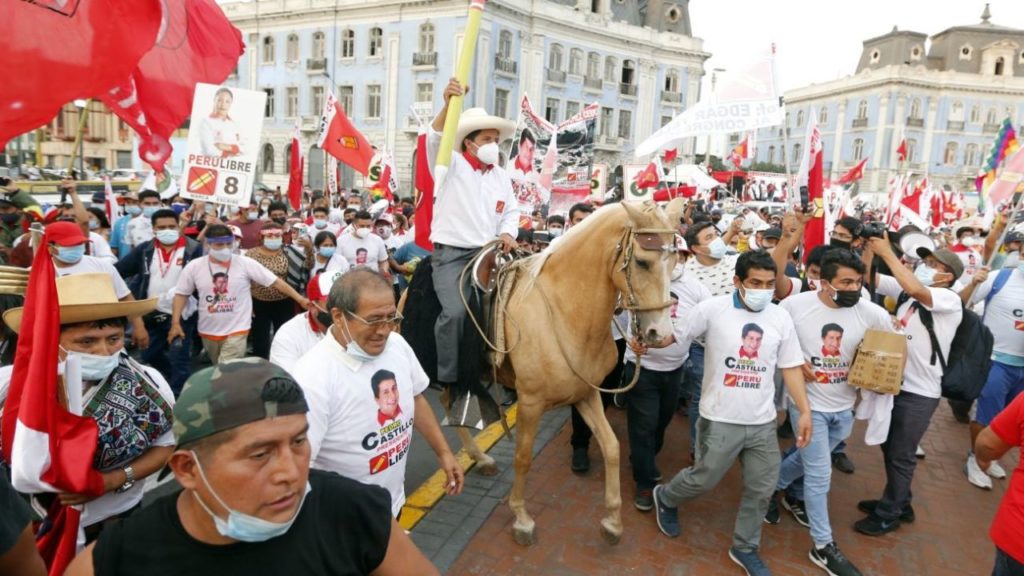
This historical moment for the poor, workers, indigenous could still be lost if it is up to right-wing militarists, former commanders, and pro-Fujimori judges.
As of June 20, still no final word of who actually is the next president. Keiko Fujimori appealed 200,000 votes at 943 polling stations for being “manipulated” with “fraudulent signatures,” and claimed that there were “impersonations of polling station members” in polling stations.
The Special Electoral Jury (JEE) completed its recount of those cases, on June 19, and found the claims all to be “inappropriate” and “unfounded.”
Fujimori appealed to the highest instance, the National Electoral Jury (JNE), which has so far not found any evidence of fraud. Still, Popular Force demands it count again. The JNE should come to a conclusion any day now. See Elecciones 2021: Fuerza Popular pierde en Jurado Electoral Especial y lanza arremetida judicial.
“The threat of political violence or even a military coup is real. Fujimori’s followers have staged fascistic demonstrations, replete with torches and the singing of the national anthem while giving the Nazi salute…” See Peru ending second week since presidential election with no declared winner.
“[Sixty-three] retired generals and other high-ranking officers issued a communique demanding the resignation of the head of the election board, warning of the danger of a Castillo victory and calling for the ‘strengthening of confidence in the armed forces and the police.’ The Defense Ministry felt compelled to issue a statement in response deploring the use of official military symbols in the communique.”
Telesur followed this announcement up on June 15:
“Peru’s Armed Forces on Monday stated their respect for the constitutional order and disassociated themselves from versions of a coup d’état in this South American country, which is still awaiting the official declaration of Free Peru candidate Pedro Castillo as the winner of the June 6 presidential elections.”
“’We regret the political use of the Armed Forces because this not only undermines their institutionality, but also generates alarm, anxiety, and division at a time when the country requires unity and calm,’ the Defense Ministry said.
“The statement pointed out that the Armed Forces had ‘an exemplary role’ in the elections guaranteeing the free exercise of the right to vote and protecting electoral officials. ‘Their mission in this electoral process has been fulfilled.’” See Peru’s Armed Forces Disassociate Themselves From Coup Attempts.
By June 18, the daily La Republica reported that nothing substantial had yet occurred to ward off this threat. Its front page article was headlined: “Retired former military high-ranking officers instigate rebellion of armed institutes!”
The next day, Minister of Defense Nuria Esparch “sent the letter to the Attorney General (Fiscalía) asking for it to determine if the letter is evidence of a ‘crime of conspiracy.” She also stated that there were no signatures on the letter and that six of those named were dead.
The current president since 2016, Francisco Sagasti, also condemned the letter as an “inacceptable incitement.” See Esparch sobre exmilitares: Habrían cometido delito vinculado a la conspiración.
Will Peru Be Part of a Renewed Pink Tide?
Although Ecuador’s socialist presidential candidate Andrés Arauz lost to Ecuador’s former Coca Cola director, banker millionaire Guillermo Lasso, last April, the Latin American pink tide from the beginning of the 21st century appears to be reviving after other recent defeats.
Bolivia’s new socialist President Luis Arce, Argentina’s President Alberto Fernandez, Nicaragua’s President Daniel Ortega, Ecuador’s former President Rafael Correa, Brazil’s ex-Presidents Lula Da Silva and Dilma Rousseff, and Colombia’s ex-Senator Piedad Cordoba sent joyful messages.
In the April 11 general election, Castillo led the race of 18 candidates with 19% of the voters. He had never engaged in parliamentary politics. Keiko Fujimori, a congresswoman from 2011 to 2016, took second place with 13.36%. In 2011, she barely lost to liberal-leftist Ollanta Humala with 51.5%. In 2016, Pedro Pablo Kuczynski squeaked by with 50.12% of the voters.
(See my background piece for this election: Left-Wing Populist, Pedro Castillo, Leads Polls Before June 6th Election in Peru – CovertAction Magazine)
The fact that the JNE has delayed announcing the official victor has encouraged turmoil and demonstrations in front of JNE and ONPE leaders’ houses.
“A group of supporters of the presidential candidate of The Popular Force, Keiko Fujimori, approached the exterior of the house of Magistrate Jorge Rodríguez Vélez, a member of the plenary session of the National Elections Jury (JNE), to hold a sit-in.” They shouted, “Respect my vote, JNE.”
“Another call is being made today, so I can say it’s a systematic thing … They are not going to scare us,” Rodríguez responded.
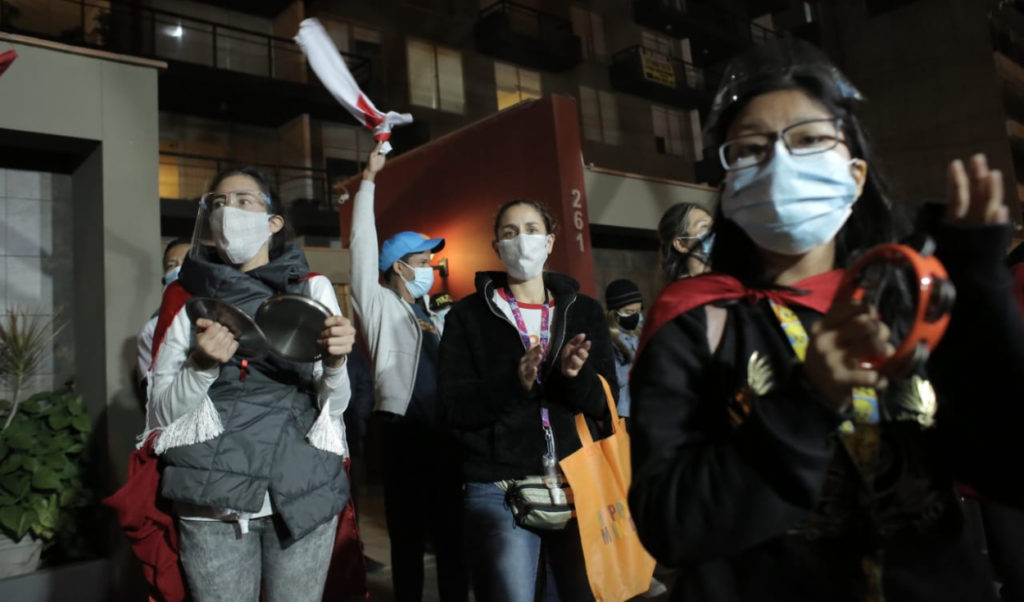
Although election committee officials did not announce the new president victor the final day of counting, the national media did. The moderate La Republica headlined: “Pedro Castillo wins over Keiko Fujimori by ballots 100% counted.”
Peruvian voters were faced with two extremes unlike in previous elections, and many were unhappy that a moderate candidate did not make the run-off. Peruvians had the choice of taking a chance with a major change in the economy towards benefiting the poor and the working class, or bringing in the daughter of former President Alberto Fujimori.
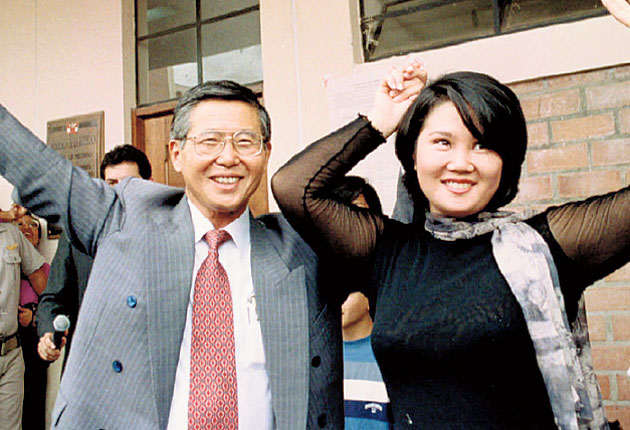
He is serving time for ordering the murder of 25 persons by a secret death squad whose killers were military men, in addition to massive corruption, receiving bribes and other crimes committed while his daughter was his adviser.
On October 10, 2018, Keiko Fujimori was arrested on charges of money laundering, illegally receiving money for her 2011 and 2016 presidential campaigns from the Brazilian Odebrecht real estate and construction company, for several other corruption cases, including leading a criminal organization.
She was sentenced to three years’ pre-trial detention as a “high escape risk.” The prosecution seeks 30 years’ imprisonment. Keiko Fujimori was released on bail under house arrest on May 5, 2020.
On June 10, Peru’s anti-corruption prosecutor José Domingo Pérez asked the judiciary to order a new pre-trial detention for Keiko Fujimori’s interference in the ongoing criminal investigations.
“It has been determined once again that the defendant Fujimori Higuchi does not comply with the restriction of not communicating with witnesses,” said the prosecutor.
Fujimori is still under investigation for the Odebrecht case, one of the most significant bribery and graft scandals in Latin America. The prosecutor told the court that she “is communicating with Miguel Torres Morales,” a witness to alleged illegal campaign financing for Fujimori’s 2011 and 2016 presidential bids.
For Keiko Fujimori, this election determines whether she goes to prison for a long time or takes the reigns as chief of state.
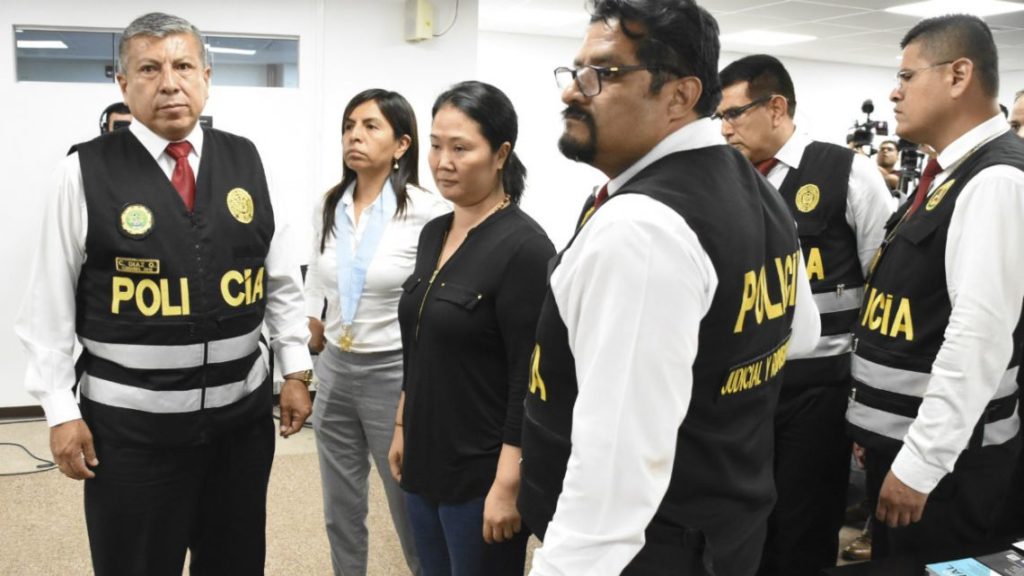
Daniel Espinosa, a Peruvian journalist compared what Keiko Fujimori is doing—“attempting to compel the masses into the streets in a move that is as irresponsible as it is dangerous”—to what Donald Trump did by “inciting his fanatics to storm the U.S. Capitol.”
La Republica cited what Washington Post columnist Marco Aviles wrote about Keiko Fujimori’s refusal to accept Castillo’s victory as part of her long history of racism towards indigenous peoples.
Keiko Fujimori originally filed a lawsuit of 802 cases of fraud against electoral authorities and requested a computer audit of the digitalized electoral records before the current 943 claims of fraud in the country and abroad.
The electoral juries rejected most of them, because they were presented after the legal deadline, and there was little or no evidence of fraud at the polling stations.
From the start of counting the votes following 12 hours of casting ballots on June 6, who led had been nip and tuck. One or the other candidate had led by from 0.1 to 0.5% of the votes. Following a short-held lead by Castillo, Fujimori led in urban areas.
She held the lead throughout Sunday evening and early Monday. Later in the day with more rural votes counted, the tide turned in Castillo’s favor. Fujimori immediately claimed that his party had “distort[ed] or delay[ed] results that reflect[ed] the will of the people.” How this was to have happened was not forthcoming, but she called upon her supporters to protest.
Peru’s currency (sol) “headed to its biggest drop in more than a decade and the S&P/BVL Peru General Index fell as much as 5.8%, the most since November, with mining companies and financial firms among the hardest hit.
Overseas bonds were steady in light trading while the cost to insure against a default edged higher … after investor favorite Keiko Fujimori saw her early lead over leftist opponent Pedro Castillo fade overnight and in the early morning.”
With almost 93% of votes counted [morning of June 7], Fujimori had 50.1% support to 49.9% for Castillo, a former farmer and then school teacher and union organizer from the Peruvian highlands. Castillo traded places once 94% were counted: 50.7% to Fujimori’s 49.92%.
Vote counting slowed. One day, only 451 votes were counted. In one example of alleged “fraud,” a village where 197 people voted, only one favored Fujimori. Vote counters, election observers and ONPE found no fraud. Even the pro-U.S. Organization of American States leadership stated that there had been no fraud.
While Fujimori won every district in Lima’s capital region, the unionist teacher, who had led an important teacher strike in 2017, and whose parents are illiterate peasants, is overwhelmingly supported in the countryside.
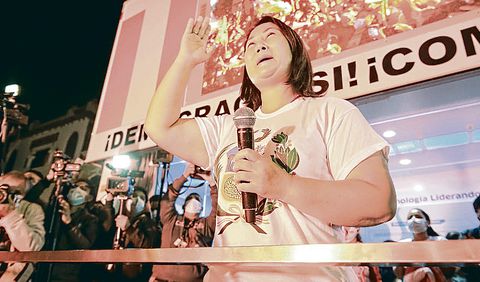
Castillo stands for reforming the economy with greater state control over markets and natural resources; curtailing mining; increasing public works and social welfare spending with a 30% cut from corporate profits gained from the use of fossil fuels; and increasing pensions and wages. Fujimori wants more of the same “free market economy,” and spreads fear of “communism” taking over the country internally.
The corporate and White House favorite is also supported by Peruvian middle and upper class urban women simply because she is a woman. Fujimori is supported by celebrities, wealthy players on the national soccer team, and the nation’s most famous author, Mario Vargas Llosa.
The former communist sympathizer turned extreme conservative was the recipient of the 2010 Nobel Prize in Literature. He even campaigned for Fujimori without regret. According to Vargas Llosa, she is the best of the “lesser of evils”; he said that her conduct is “very decent.”

Fear Tactics
Upon completion of voting, National Elections Board (JNE) chairman Jorge Luis Salas stated that there were 166 international observers and 1,400 Transparency Civil Association observers monitoring the voting process.
“Conditions for reasonable and transparent elections are in place,” Salas added.
Furthermore, tens of thousands of police and soldiers were on patrol on election day. They reported no instances of chaos or violence. There were, however, a few hundred reports of bringing candidate propaganda into voting areas.
Many people fear that the military, or parts of it, will align with Fujimori to prevent the worker socialist from leading the country.
Three days before the final count, Daniel Espinosa wrote:
“So far, the Peruvian military has respected its mandate as a non-deliberative body, and has avoided interfering in the political contest. Even the Organization of American States and Human Rights Watch, two bodies which normally side with right-wing candidates in Latin America have openly rejected Fujimori´s accusations of fraud and called for a swift resolution of her weak complaints. For their part, international observers agree that the poll was clean.”
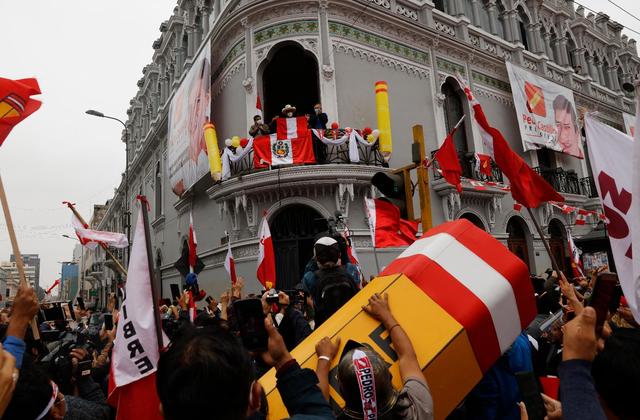
Fujimorism mobs are attacking prominent figures on the streets who stand by Pedro Castillo. Some of their houses have been surrounded and threats shouted. A totalitarian atmosphere is developing, according to one of the few dailies not in Fujimori’s pocket.
Fujimori and her rich backers are endeavoring to destabilize the country, to prevent Castillo from assuming the presidency, or lay the basis for his overthrow once in office—a strategy she may have learned from the CIA and her years in the United States.
Fujimori received her college education in business administration. She married an American, Mark Villanella, an IBM consultant. She was involved with the Mossack Fonseca tax evasion shelters known from the Panama Papers. When she first ran for the presidency, she hired former New York City mayor and Donald Trump lawyer Rudy Giuliani as an adviser.
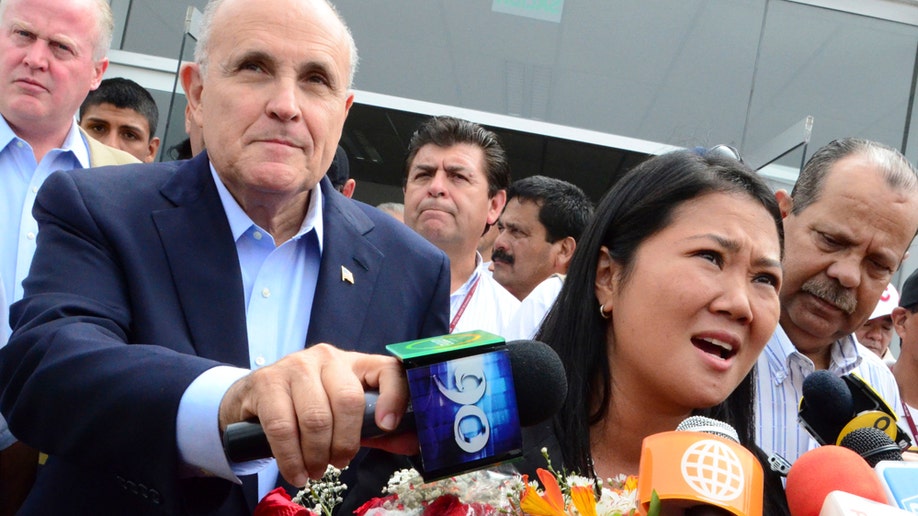
In a June 14 editorial, the moderate daily The Republic called indirectly upon the Popular Force party to stop creating “instability”: “The chaos caused by a sector that intends to review what has been revised, to open up what is already legally closed and, finally, to deduct votes from the rival, in order to win, cannot be answered with indifference.”
Waya, another Peruvian paper, wrote that this election will be remembered for “citizen polarization, the psycho-socials, the false news and the fear campaigns that have been deployed at the national level to direct the vote towards the presidential candidate Keiko Fujimori.”
For the business elite, its media, the police and military leaderships, the only real danger to “democracy,” as they see it, is Pedro Castillo. All the endemic pro-capitalist political corruption, bribes, swindles and murders are apparently of no consequence when confronting socialism, which aims to equalize rights and benefits, end military “solutions” to struggles resisting poverty, injustices, and wars for profit.
The hundreds of U.S. businesses in Peru include scores of chemical companies. Peru is the world’s second largest copper producer. It is also a large source for silver, gold and zinc.
Conclusion
In the last days of the campaign, both candidates concentrated on promising total battle against the coronavirus, which, as of June 17, had taken 189,522 Peruvian lives and infected 2,015,190. Peru leads the world in percentage of deaths per capita: 572.3 per 100,000. Of its 33.3 million population, more than two million have been infected. Peru’s per capita death rate is nearly double that of Hungary, the country with the second highest rate of deaths per 100,000 population at 305.
At the end of the ballot tally, the state announced a curfew in Lima and Callao from 11 p.m. to 4 a.m., in an effort to curtail the spread of Covid-19 infections and deaths.
Peru’s ethnic makeup (self-identified) is 60% mestizo; 27% indigenous (85% are Quechuas, the remainder are Aymaras and Amazonians); 5% white, ca. 2% black/mulatto, and 6.7% others.
Voting is mandatory in Peru for all persons aged 18 to 70. Turnout in this election, at 74%, was lower than the 82% in 2016 but still high.
Latin America’s poor and Indigenous peoples will be watching with hope to see what this feisty farmer-teacher-unionist will attempt to accomplish as a socialist president. Peru’s rich, its military and police leaderships, and Wall Street/Pentagon/CIA will be watching too.
Just in the last generation, the U.S. has backed at least nine coups or coup attempts against progressive or socialist presidents.
In 2002 against Venezuela’s Hugo Chavez (unsuccessful); in 2004 against Haiti’s Jean-Bertrand Aristide (successful); in 2009 against Honduras’ Manuel Zelaya (successful); in 2010 against Ecuador’s Rafael Correa (unsuccessful); in 2018 against Nicaragua’s Daniel Ortega—the former revolutionary and progressive (unsuccessful); and in 2019 against Bolivia’s Evo Morales (successful).
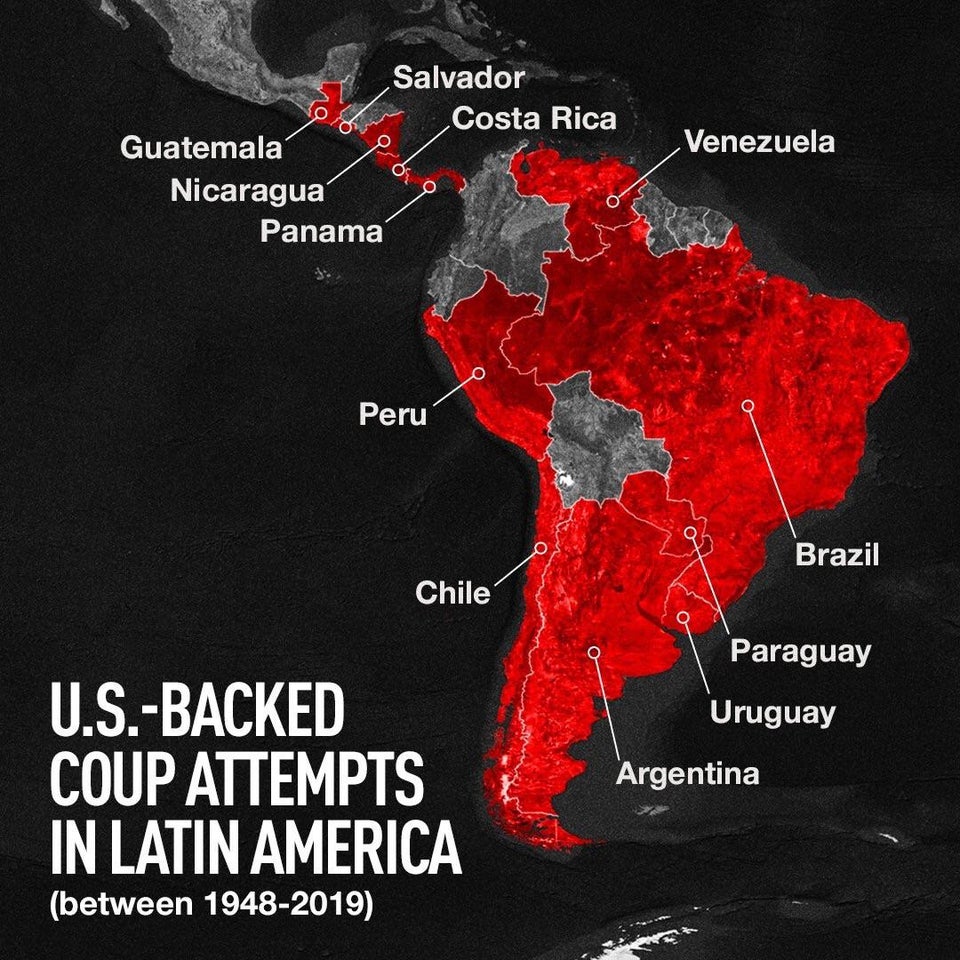
The U.S. has also blessed right-wing parliamentary coups—in 2012 against Honduras’s Supreme Court; in 2012 against Paraguay’s President Fernando Lugo; and in 2016 against Brazil’s Dilma Rousseff.
Records show, in the last century, at least 87 coups in South America and the Caribbean, all either conducted directly by the self-proclaimed “greatest democracy,” the United States of America, or by its wealthy Latin American and military proxies.

CovertAction Magazine is made possible by subscriptions, orders and donations from readers like you.
Blow the Whistle on U.S. Imperialism
Click the whistle and donate
When you donate to CovertAction Magazine, you are supporting investigative journalism. Your contributions go directly to supporting the development, production, editing, and dissemination of the Magazine.
CovertAction Magazine does not receive corporate or government sponsorship. Yet, we hold a steadfast commitment to providing compensation for writers, editorial and technical support. Your support helps facilitate this compensation as well as increase the caliber of this work.
Please make a donation by clicking on the donate logo above and enter the amount and your credit or debit card information.
CovertAction Institute, Inc. (CAI) is a 501(c)(3) non-profit organization and your gift is tax-deductible for federal income purposes. CAI’s tax-exempt ID number is 87-2461683.
We sincerely thank you for your support.
Disclaimer: The contents of this article are the sole responsibility of the author(s). CovertAction Institute, Inc. (CAI), including its Board of Directors (BD), Editorial Board (EB), Advisory Board (AB), staff, volunteers and its projects (including CovertAction Magazine) are not responsible for any inaccurate or incorrect statement in this article. This article also does not necessarily represent the views the BD, the EB, the AB, staff, volunteers, or any members of its projects.
Differing viewpoints: CAM publishes articles with differing viewpoints in an effort to nurture vibrant debate and thoughtful critical analysis. Feel free to comment on the articles in the comment section and/or send your letters to the Editors, which we will publish in the Letters column.
Copyrighted Material: This web site may contain copyrighted material the use of which has not always been specifically authorized by the copyright owner. As a not-for-profit charitable organization incorporated in the State of New York, we are making such material available in an effort to advance the understanding of humanity’s problems and hopefully to help find solutions for those problems. We believe this constitutes a ‘fair use’ of any such copyrighted material as provided for in section 107 of the US Copyright Law. You can read more about ‘fair use’ and US Copyright Law at the Legal Information Institute of Cornell Law School.
Republishing: CovertAction Magazine (CAM) grants permission to cross-post CAM articles on not-for-profit community internet sites as long as the source is acknowledged together with a hyperlink to the original CovertAction Magazine article. Also, kindly let us know at info@CovertActionMagazine.com. For publication of CAM articles in print or other forms including commercial internet sites, contact: info@CovertActionMagazine.com.
By using this site, you agree to these terms above.
About the Author

Ron Ridenour is a U.S.-born author and journalist, anti-war and civil rights activist since 1961. After joining the U.S. Air Force at 17, he saw the inner workings of U.S. imperialism first hand and resigned. In the 1980s and 1990’s he worked with the Nicaraguan government and on Cuban national media.
He now lives in Denmark and, in addition to writing a dozen books, has served as a special correspondent and freelance investigative journalist for many publications in the U.S. and several Latin American and European countries—among them: The Morning Star, New Statesman, The Guardian (U.S. and England), Playboy, Liberation News Service, Pacific News Service, Coast Magazine, Qui, Skeptic, Seven Days, and Pacifica Radio.
CAM co-founder Philip Agee wrote commentaries to two of his dozen books: Yankee Sandinistas: Interviews with North Americans Living and Working in the New Nicaragua, and Backfire: CIA’s Biggest Burn. See also: The Russian Peace Threat: Pentagon on Alert and Winding Brook Stories at Amazon and Lulu. Other work can be found at ronridenour.com.
Ron can be reached at ronrorama@gmail.com.

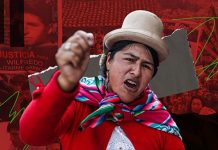


Great article!!
Hi Ron,
Congratulations***
John Kelly